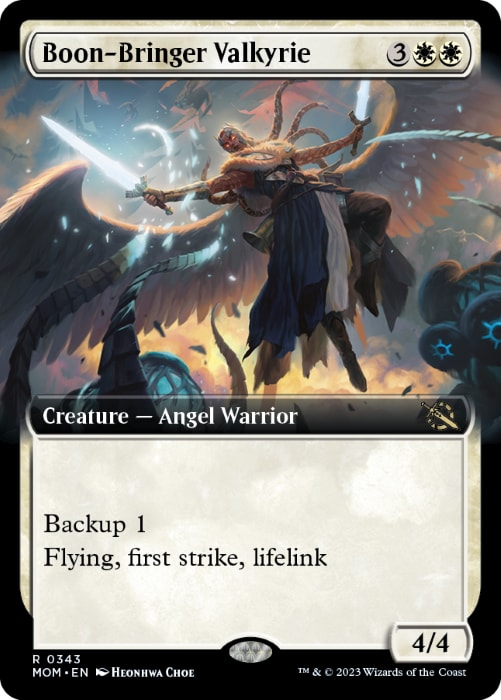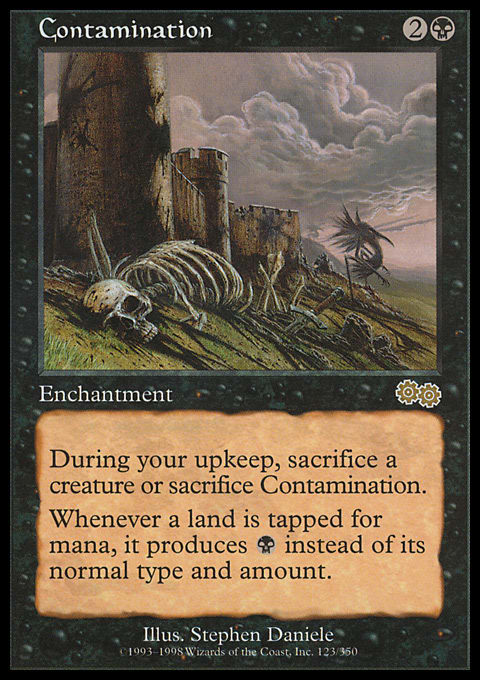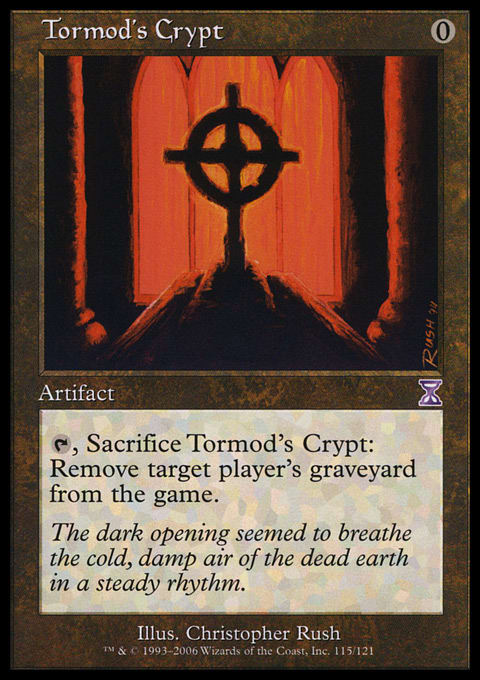Have you seen this style of deck?
Mono-Red | OTJ Standard | Edel, 4th Place MTGO Standard Challenge 5/12/2024
- Creatures (12)
- 4 Bloodthirsty Adversary
- 4 Monastery Swiftspear
- 4 Slickshot Show-Off
- Instants (13)
- 2 Witchstalker Frenzy
- 3 Lightning Strike
- 4 Monstrous Rage
- 4 Play with Fire
- Sorceries (4)
- 2 Obliterating Bolt
- 2 Scorching Shot
- Enchantments (4)
- 4 Kumano Faces Kakkazan // Etching of Kumano
- Artifacts (4)
- 4 Urabrask's Forge
- Lands (23)
- 17 Mountain
- 2 Sokenzan, Crucible of Defiance
- 4 Mishra's Foundry
I was a little surprised the first time I looked it over. My frame of reference for Outlaws of Thunder Junction Standard Red Decks was kind of half-Pioneer and half-Best of One queues. Both those styles tend to be even more focused on offense, even if Edel's version ran newcomer Slickshot Show-Off and Monstrous Rage (not all of this brand does). Many versions run Fugitive Codebreaker, and extreme versions verge on combo, sometimes splashing Green for Picnic Ruiner or Black for a Cacophony Scamp + Callous Sell-Sword // Burn Together end game flourish.
This Red Deck, popularized by a Pro Tour Hall of Famer, is more emblematic for Best-of-Three Standard though, and ergo, the kind you'd most likely have come up against at last weekend's Regional Championship in Dallas.
It's a weird bird.
Not only does it not jam the pedal to the floor, it does play all kinds of nonsense that can't damage the opposing player. Exiling with Obliterating Bolt? Isn't Scorching Shot - admittedly a decent Sheoldred slayer - more of a sideboard card? Especially in a deck that also has access to Witchstalker Frenzy?
The deck is also kind of a clunker. Is there any more high variance a sideboard card than End the Festivities? So awesome... Sometimes. Can't kill a single weenie out of Boros if they pre-empt with Warleader's Call.
But I found that it just won. It won and won and so often in surprising ways. My draw might suck but their draw sucked worse. I'd be one-spelling a creature every turn (because I kept drawing spot removal with barely a clock)... But at some point they'd be overwhelmed by Urabrask's Forge. Desperate five damage topdecks against a Legendary big Black creature. Of course, there was the odd game where I'd open with Kumano Faces Kakkazan // Etching of Kumano into whatever. 3/3 Bloodthirsty Adversary in the *ahem* Red Zone on turn two hasn't ceased to be game, though.
But the thing that makes this deck special is how deftly it defies Stage theory.
In late 2007 I put together a framework that a nice editor wrote was not "The Grand Unified Theory of Magic: The Gathering, but [was] the closest thing we've got."
Briefly, I tried to define the three Stages of a Magic game:
Stage I: Basically Manascrewed.
You haven't crossed a Minimum Game Threshold to actually be able to play your game. Beatdown decks historically cross this at about two mana (even less in 2024) whereas control decks get there at about four mana. A lot of the changes in control decks over time - including the recent emphasis on flawed but flexible answers like No More Lies or March of Otherworldly Light - are attempts to close the Minimum Game Threshold faster.
Stage III
This Stage is defined by one player dictating the field of battle; where the opponent has few if any cards that are relevant. At the time I was frustrated by terms like early game, mid-game, and end game... Which didn't really mean anything. For example a Standard Azorius Control deck can play in the supposed "end game", but often has no real Stage III cards. This, we will see, is not true of the Standard Red Deck.
Stage II: Mostly Errors
Stage II is where most Magic is played. In Stage I you almost by definition aren't playing Magic. In Stage III only a subset of cards matter at all. Stage II is where all of us are futzing up every turn while trying to convince ourselves it was just a judgment call. Most card advantage is most important in Stage II. A lot of tempo matters in the latter part of Stage I, or the early parts of Stage II.
What struck me most about the Edel-style Red Deck was how specifically it played in Stage III, especially in sideboarded games. If you contrast that with a ![]()
![]() deck... The kind I qualified with has no Stage III at all. A two-Jace version, which became kind of the mode by the Regional Championship, dictates Stage III in only very specific circumstances. I once fired off a double-Jace turn against Temur in testing, only to lose to a big turn when the opponent still had one card in library.
deck... The kind I qualified with has no Stage III at all. A two-Jace version, which became kind of the mode by the Regional Championship, dictates Stage III in only very specific circumstances. I once fired off a double-Jace turn against Temur in testing, only to lose to a big turn when the opponent still had one card in library.
Intuitively, control decks are weak in Stage I, desperately trying to tempo until they get to four mana. And even at that point they're still strained a little, unable to two-spell if one of their two spells is Memory Deluge or The Wandering Emperor (arguably their two best).
Again intuitively, the Red Deck is disproportionately strong in Stage I. Kumano Faces Kakkazan // Etching of Kumano and Monastery Swiftspear look good on turn one. And while this remains true, its corollary - that the game starts to slide into control's favor approaching the end game - is not, at least not necessarily.
Unlike ![]()
![]() , the Red Deck has a powerful Stage III, and it can come on quickly.
, the Red Deck has a powerful Stage III, and it can come on quickly.
Especially in Game 1, Mono-Red can initiate the end game as early as turn three, with Urabrask's Forge. The game might not quite be over technically, but make no mistake: The game is now probably just about that Urabrask's Forge.
It's easy to see how that might be true if the Red Deck is up against u-w, but it's also true against something like Boros! At a minimum the game might become a race, explicitly. Prior to the Forge being on the battlefield, it might have been about lots of things: Does Boros have time to dicker around drawing cards with Knight-Errant of Eos? Will they give a 1/2 flying or see about sending into a hostile Red Zone on the ground?
When the Red Deck can combine Urabrask's Forge with End the Festivities and a little point removal for the bigger guys, what the game is "about" starts to look really clear against removal-poor ![]()
![]() .
.
But, of course, the better example is ![]()
![]() . Azorius has a finite number of answers to an Urabrask's Forge. Did they already blow a March of Otherworldly Light on an incoming attacker? Or can they coolly stave off Stage III before they're even in Stage II themselves by discarding a card to that pivotal Kamigawa instant?
. Azorius has a finite number of answers to an Urabrask's Forge. Did they already blow a March of Otherworldly Light on an incoming attacker? Or can they coolly stave off Stage III before they're even in Stage II themselves by discarding a card to that pivotal Kamigawa instant?
In many games, u-w will have a high enough life total to bring the game back to a Stage II that they can manage, by dealing with the Red Deck's threats one at a time, finally finding a March or Farewell for the Forge. But even then, Red might be in Inevitability gear, where every Play with Fire and Lightning Strike becomes a lethal threat.
Azorius can show its interplay via clever play. Have you ever tapped a Restless Anchorage to make itself a tapped creature, just so you could kill it with your own The Wandering Emperor? These kinds of desperate - if cool in the moment - sequences are all about recognizing the narrow band of cards that matter when Red is dictating the field of battle.
There is probably no greater acknowledgment of the Red Deck Stage III than the return of Boon-Bringer Valkyrie to ![]()
![]() sideboards. Yes, the card is a little better with Three Steps Ahead than other options. I, myself, qualified with four copies of Dennick, Pious Apprentice // Dennick, Pious Apparition in my 4x Temporary Lockdown deck. But the really big feature to this card is its first strike. That means that no matter how big an Urabrask's Forge gets, the Boon-Bringer Valkyrie can handle it for no incremental mana beyond the initial investment; giving
sideboards. Yes, the card is a little better with Three Steps Ahead than other options. I, myself, qualified with four copies of Dennick, Pious Apprentice // Dennick, Pious Apparition in my 4x Temporary Lockdown deck. But the really big feature to this card is its first strike. That means that no matter how big an Urabrask's Forge gets, the Boon-Bringer Valkyrie can handle it for no incremental mana beyond the initial investment; giving ![]()
![]() space to operate even as Red is dictating what the game is going to be about.
space to operate even as Red is dictating what the game is going to be about.
Now speaking of sideboarding, the thing that made me want to write this article is how expectations-defying the Red Deck can be, specifically in Games Two and Three.
Chandra is pretty good, but the card that flips the script across many matchups is Koth:
This is a card I played in last year's 2023 Standard Regional Championship, specifically as an additional way to contain Sheoldred, the Apocalypse and other large creatures. Koth in 2024 serves that purpose a little less, just because there are fewer Sheoldreds. But it, instead, becomes a mighty bridge to Stage III.
Once Koth is in play, the clock starts ticking in a different way. In some matchups, that means that your early game creatures turtle up: Their job is to get in the way and defend Koth. In the ![]()
![]() matchup, you are dictating that the game is very quickly going to be about Koth just killing them, and forcing them to acknowledge just how few their relevant cards are.
matchup, you are dictating that the game is very quickly going to be about Koth just killing them, and forcing them to acknowledge just how few their relevant cards are.
We said earlier that card advantage is mostly a Stage II thing. Think about how many cards a ![]()
![]() deck can draw and still not be able to deal with a resolved Koth. What have they got? Two Get Lost? They really better be gripping one. They really had best hope they didn't get cute against Kumano Faces Kakkazan // Etching of Kumano earlier, or it's Emblem City.
deck can draw and still not be able to deal with a resolved Koth. What have they got? Two Get Lost? They really better be gripping one. They really had best hope they didn't get cute against Kumano Faces Kakkazan // Etching of Kumano earlier, or it's Emblem City.
To really get a clear understanding of how Stage III works, please consider this Mono-Black deck, a brand new innovation in the closed card pool of Premodern:
Mono-Black Contamination | Premodern | McLean Denny
- Creatures (4)
- 4 Nether Spirit
- Instants (8)
- 1 Smother
- 2 Skeletal Scrying
- 2 Tainted Pact
- 3 Contagion
- Sorceries (15)
- 1 Sickening Dreams
- 1 Unmask
- 2 Reanimate
- 3 Innocent Blood
- 4 Cabal Therapy
- 4 Duress
- Enchantments (9)
- 1 Engineered Plague
- 4 Contamination
- 4 Zombie Infestation
- Lands (24)
- 4 Snow-Covered Swamp
- 4 Swamp
- 2 Bloodstained Mire
- 2 Polluted Delta
- 4 Mishra's Factory
- 4 Rishadan Port
- 4 Wasteland
- Sideboard (15)
- 2 Coffin Purge
- 1 Diabolic Edict
- 3 Dystopia
- 2 Engineered Plague
- 3 Null Rod
- 2 Perish
- 1 Sickening Dreams
- 1 Snuff Out
The combo here is one Nether Spirit + Contamination:
In order to satisfy Stage III, two things have to be going on. The Black deck has to be dictating the field of battle, and the number of cards that the opponent can draw to interact must be limited.
Imagine an opponent gets out quickly and has already littered the 'field with Jackal Pups before McLean has assembled his combo. Then, while the opponent might be stuck only tapping for Black [with no Black spells] the game might not be about that, but rather Denny's life total. Or imagine there is a Cursed Scroll in play... Clunky now, but still more-or-less operable.
Or imagine the opponent has two Mishra's Factories... Enough to overpower a 2/2.
In any of these cases the Black deck might not be dictating Stage III despite having assembled the combo.
But if it is?
How wonderful is that?
The whole notion of "card advantage" is out the window. The Black endgame revolves around:
A regular Grizzly Bears costs ![]()
![]() for a 2/2. Zombie Infestation costs
for a 2/2. Zombie Infestation costs ![]()
![]() and two additional cards for your first 2/2. But at the point that your opponent's cards have all become irrelevant, you can pitch as many of your own to make some dorks and donk with them.
and two additional cards for your first 2/2. But at the point that your opponent's cards have all become irrelevant, you can pitch as many of your own to make some dorks and donk with them.
Operating this Black deck - even beyond just assembling its combo - can be an exercise in four-dimensional chess. Luckily it is extremely well built; or at least as well built as we can call a deck with four copies of Zombie Infestation. Check out the mix of Bloodstained Mires, Polluted Deltas, basic Swamps, and Snow-Covered Swamps. These cards all make Tainted Pact a little better, while helping to enable Skeletal Scrying (which, itself, can clear a second - or third - Nether Spirit from the graveyard).
Part of its being well built involves the Null Rods in the sideboard. Any opponent can potentially crack the Contamination combo with an artifact like Tormod's Crypt or Phyrexian Furnace.
So McLean's deck anticipates this with the second-order sideboard card ("sideboard card against sideboard cards") of Null Rod.
If you're interested in hearing more about the Contamination deck, it's a topic of the most recent Spike Colony; but here I thought it was just the most explicit (and recent!) illustration of Stage III that I could come up with, outside of Standard Red.
I'd say enjoy burning out your opponents with a Hall of Fame vehicle for the most underrated 1-drop of all time, but more than likely you'll be doing it with x/1 tramplers and bonking with basic Mountain.
LOVE
MIKE


































